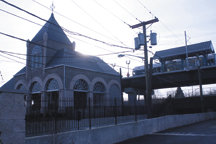At 9 a.m. on Saturday, Dec. 11, smoke began to billow out of the new Eighth Street station of the Hudson Bergen Light Rail just as a train pulled in.
This was not a real fire, but a complicated, multiple disaster exercise designed to test the emergency response capabilities of numerous groups before the station officially opened.
“This is an elevated train platform,” said Mickey McCabe, founder of McCabe Ambulance Service in Bayonne, which was one of the emergency response teams that would have to respond had this been a real emergency. “Nobody has had to deal with an emergency situation here before. So this is a way for us to learn about the facility and what we might expect if there is an actual emergency.”
“Nobody has had to deal with an emergency situation here before.” – Mickey McCabe
________
“This event takes place in real time,” said Dan Stessel, director of N.J. Transit Media Relations.
Under this scenario, the train was just leaving the station when one of the cars became derailed on the elevated track, causing injuries to some of the passengers. Set in several locations, the walking survivors were evacuated from the elevated section, while rescue workers used an elevated fire platform and other equipment to bring down the more seriously injured – these represented by dummies.
“One of the things that is new here,” said Bayonne Fire Chief Greg Rogers, “is the fact that medical people have not used the elevated platform before.”
Bayonne Mayor Mark Smith and Assembly Jason O’Donnell – who also serves as public safety director for Bayonne – were on hand to watch the activities.
“This is something we need to do,” Smith said. “The station is expected to begin operations in 2011.”
O’Donnell said the training exercise is necessary in order to prepare local responders in the event of an emergency.
McCabe said when a rail disaster like the one simulated takes place, a number of things happen. A local and statewide notice goes out to alert everyone that there has been a problem, and if there is a suspicion of a terroristic element, a Code Black Alert is issued, at which point all rail operations in the state cease.
In this exercise, however, the situation involved multiple disasters, such as a fire breaking out in the train station, limiting the ability of rescue workers to use that as a way to reach and rescue the train victims. The drill also forced emergency management to allocate resources to deal with each problem.
“The Bayonne Fire Department teamed up with N.J. Transit police, Bayonne police, EMS, and other emergency responders to hone our skills at dealing with a mass transit emergency,” said Fire Chief Rogers. “Today’s drill was timely and necessary, since the extension of light rail and the opening of the Eighth Street Station will take place soon. I was particularly pleased with the Fire Department’s rescue crew performance, involving elevated platform, high-angle rescue activity in coordination with police and EMS crews. The Fire Department will team again with N.J. Transit to pursue further training opportunities involving rail emergency preparation.”
Among those included in the response: New Jersey Transit Police Department, Hudson-Bergen Light Rail, the Bayonne Police Department, the Bayonne Fire Department, McCabe Ambulance EMS, the Bayonne Office of Emergency Management, the Hudson County Office of Emergency Management, the New Jersey State Police Office of Emergency Management, the New Jersey State EMS Task Force, and the FBI-Joint Terrorism Task Force.
In a situation like this, Rogers said, the Fire Department would largely take the lead role because of its expertise with the equipment and its first responder skills. But who coordinates responses depends entirely on the situation and whether or not it is a terroristic threat or even if it had regional implication.
“If the federal authorities decide to take over a situation, then they coordinate things,” Rogers said. “But even then, local emergency groups, like the Bayonne Department – who had the expertise and experience in this area – would play a vital role.”
Al Sullivan may be reached at asullivan@hudsonreporter.com.
